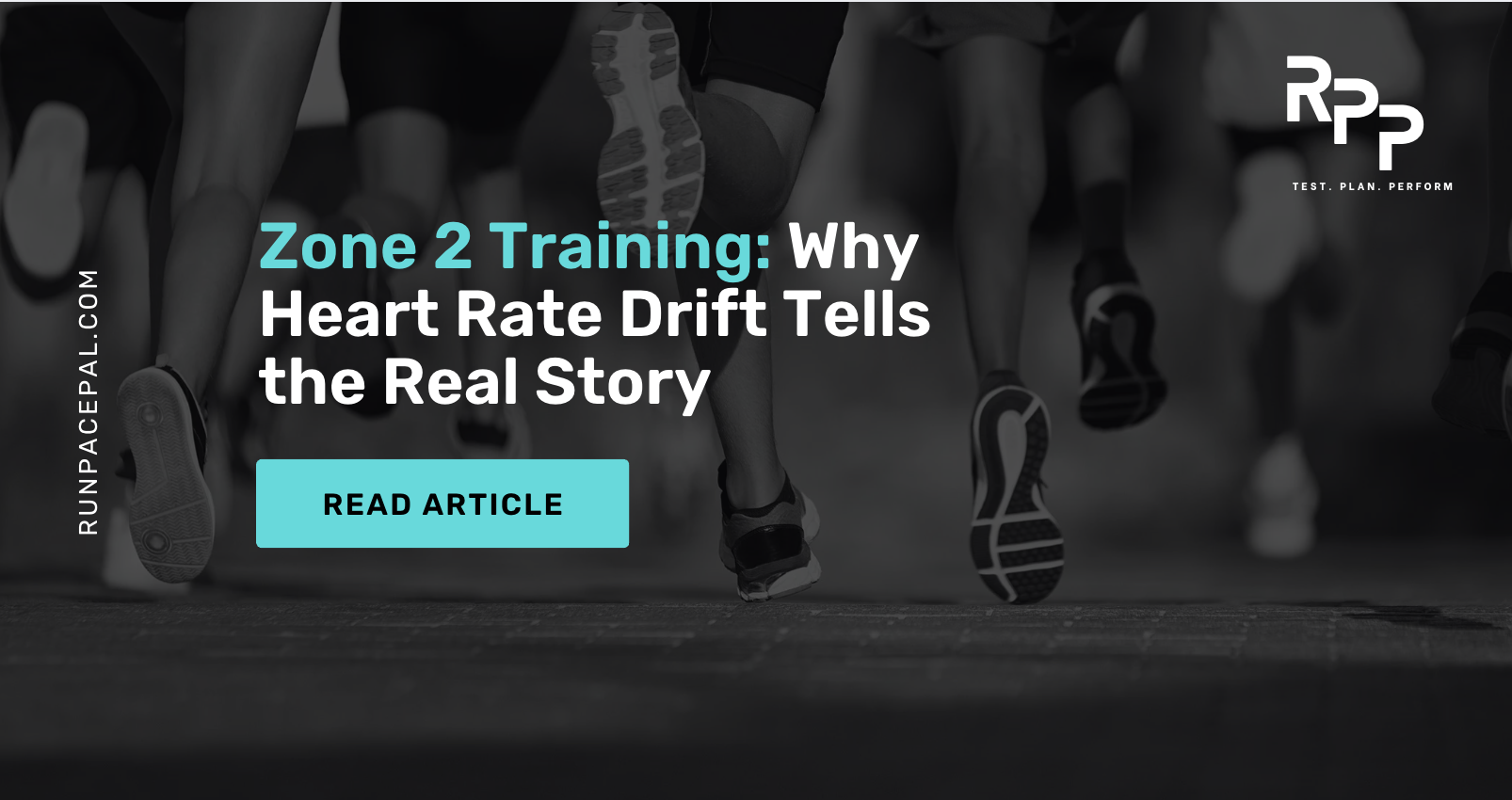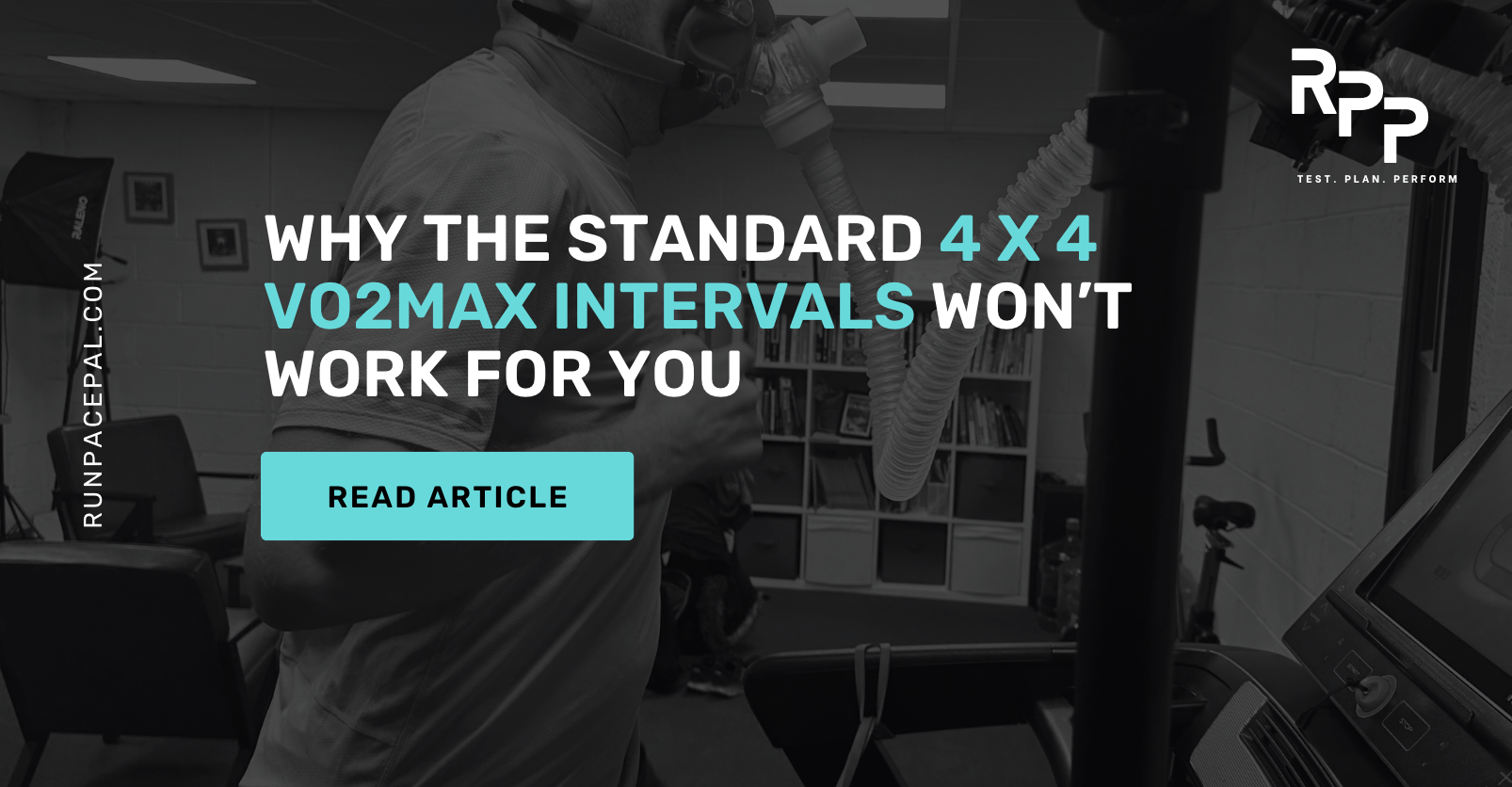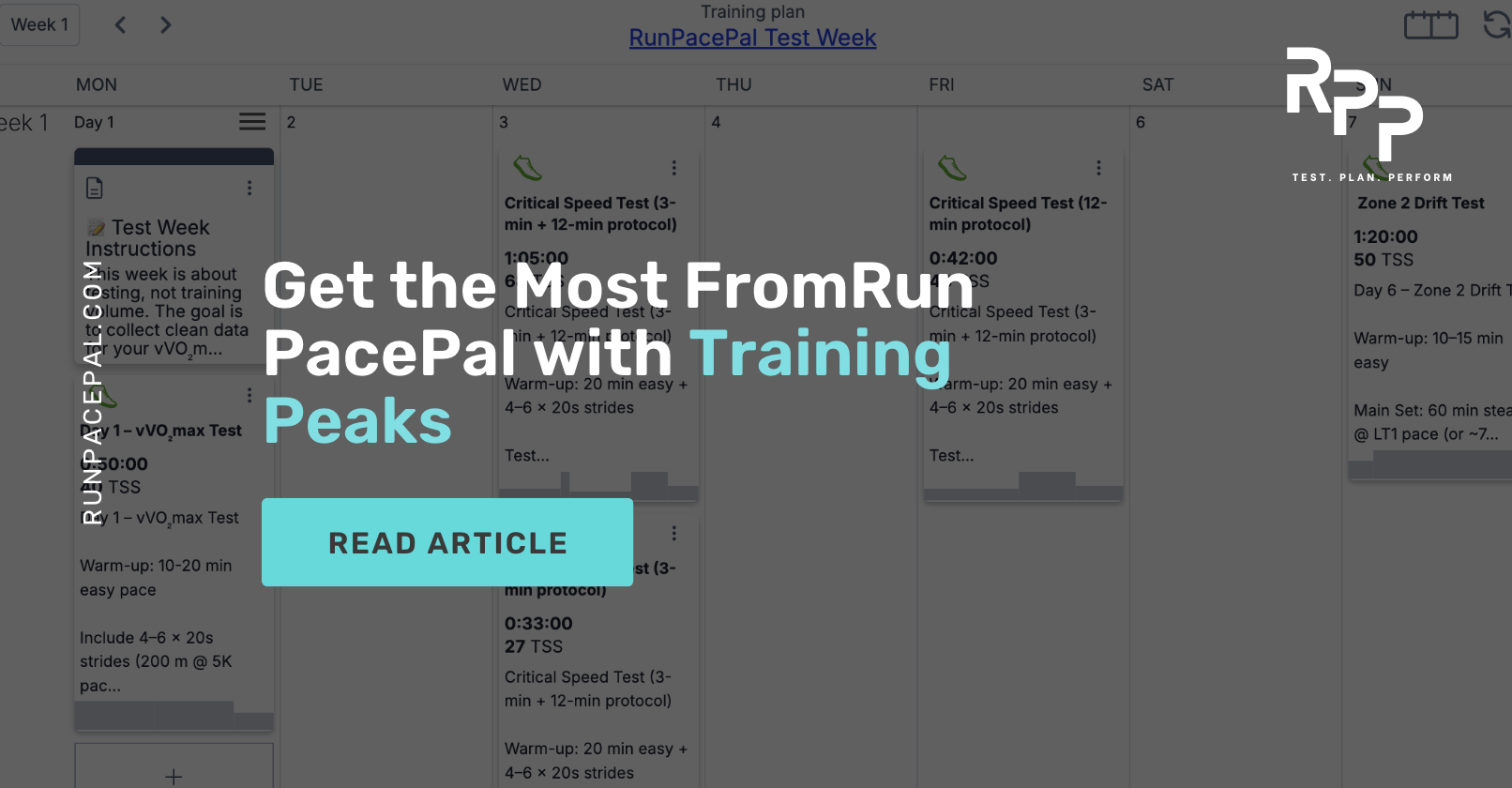Zone 2 Training: Why Heart Rate Drift Tells the Real Story
Zone 2 training has become one of the hottest topics in endurance sport. From marathon runners to HYROX athletes, everyone is talking about "building the aerobic base."
But here's the problem: most athletes guess Zone 2 using outdated formulas like 180 minus your age — and end up running either too hard (ruining recovery) or too easy (missing the benefit).
The real answer lies in heart rate drift testing.
🔬 What Is Zone 2 Training?
Zone 2 is your aerobic base zone — the effort where you can run while primarily burning fat and keeping lactate levels stable around your first lactate threshold (LT1).
The Science Behind Zone 2
Research by Seiler & Kjerland (2006) established that elite endurance athletes spend approximately 80% of training time below LT1 (aerobic threshold), with only 20% at higher intensities. This "polarized" approach maximizes aerobic adaptations while allowing adequate recovery.
Zone 2 Training Characteristics: - Feels: "Comfortably conversational" — you can speak in full sentences - Physiologically: Fat oxidation dominates, lactate remains stable (<2 mmol/L) - Benefits: Improves mitochondrial density, capillary development, and endurance capacity - Risk: Running too hard pushes you above LT1, compromising recovery and aerobic development
Research Evidence: Stöggl & Sperlich (2014) demonstrated that polarized training (80% easy, 20% hard) produces superior endurance adaptations compared to threshold-heavy or high-volume approaches (Frontiers in Physiology).
📉 Heart Rate Drift: The Key to Accuracy
As you run at a steady pace, your heart rate naturally creeps up over time. This phenomenon is called cardiac drift or HR drift.
The Drift Test Principle
- If HR drifts less than ~5%, you're in true Zone 2 (below LT1)
- If HR drifts more than ~5%, you've slipped above your aerobic threshold
- This is why formulas like "220 minus age" don't work — they don't reflect your individual physiology
Why Traditional Formulas Fail
The popular 180-age formula (MAF method) and 220-age maximum predictions have significant limitations:
Scientific Problems: - Tanaka et al. (2001) showed that 220-age formula has a standard deviation of ±10-12 bpm - Robergs & Landwehr (2002) demonstrated this formula lacks scientific foundation - Individual variation can be 20+ bpm from predicted values
Real-World Impact: One runner's "Zone 2" at 140 bpm might be another's lactate threshold pace.
📊 The HR Drift Test: Step-by-Step Protocol
Instead of guessing, use this scientifically-validated approach to identify your true Zone 2:
Testing Protocol
Preparation: - Well-rested state (no hard training 24-48 hours prior) - Consistent environmental conditions (avoid extreme heat/humidity) - Properly calibrated heart rate monitor
Test Structure: 1. 15-minute warm-up at very easy pace 2. 45-60 minutes at target effort - aim for what feels "conversational" 3. 10-minute cool-down
Data Analysis & Interpretation
Calculate Pa:Hr Decoupling: - First half average HR vs. Second half average HR - Drift % = [(2nd half HR - 1st half HR) / 1st half HR] × 100
Decision Thresholds:
- ≤3% drift: Solid Zone 2 — excellent aerobic base pace
- 3-5% drift: Borderline — consider reducing intensity slightly
- >5% drift: Above LT1 — significantly reduce intensity
Example Calculation
Test Data: - First 30 minutes: Average HR 142 bpm - Second 30 minutes: Average HR 148 bpm - Drift = [(148-142)/142] × 100 = 4.2%
Interpretation: Borderline Zone 2. Reduce intensity by 5-10 bpm for future sessions.
🔬 Methods Comparison: Finding Your LT1
Multiple methods exist for identifying aerobic threshold. Here's how they compare:
| Method | Accuracy | Cost | Accessibility | Best Use |
|---|---|---|---|---|
| HR Drift Test | High | Free | Excellent | Field testing, ongoing monitoring |
| Lactate Testing | Gold Standard | $$$ | Lab only | Precise threshold identification |
| DFA α1 (HRV) | High | $ | Good | Tech-savvy athletes with advanced devices |
| Ventilatory Testing | High | $$$ | Lab only | Comprehensive metabolic profiling |
| 180-Age Formula | Poor | Free | Excellent | Rough starting point only |
Advanced Field Method: DFA α1
Rogers & Gronwald (2021) demonstrated that DFA α1 analysis of heart rate variability can identify aerobic threshold in real-time. When DFA α1 drops to ~0.75, you've likely reached LT1.
Advantages: - Real-time feedback during training - No need for extended drift testing - Works across different exercise modalities
Requirements: - Advanced HRV-capable device (Polar, Garmin with compatible apps) - Understanding of data interpretation
⚡ HYROX-Specific Zone 2 Application
For HYROX athletes, Zone 2 training serves multiple strategic purposes:
Weekly Training Integration
Base Phase (12-16 weeks out): - 3-4 Zone 2 sessions per week (45-75 minutes) - 2 functional strength sessions - 1 race-pace simulation
Build Phase (6-8 weeks out): - 2-3 Zone 2 sessions per week (30-60 minutes) - 2-3 high-intensity sessions (VO₂max/threshold work) - 2 functional strength + conditioning sessions
Cross-Training Considerations
Modality Equivalence: - Running: Use HR drift testing directly - Rowing/Bike Erg: HR typically 5-10 bpm lower than running - Ski Erg: HR similar to running for upper-body dominant athletes
Station Recovery Application: - Between functional stations: Drop to Zone 2 HR for active recovery - Aerobic base development: Improves recovery between high-intensity efforts - Metabolic efficiency: Enhanced fat oxidation during longer events
🛠 Troubleshooting: Common Issues & Solutions
"My drift is 7% but the effort feels easy"
Possible causes: - Environmental factors (heat, humidity, dehydration) - Insufficient warm-up period - Heart rate monitor drift or poor contact - Recent training stress affecting cardiac efficiency
Solutions: - Retest in cooler conditions with proper hydration - Extend warm-up to 20-25 minutes - Check HRM fit and battery; consider chest strap vs. wrist-based - Ensure 48+ hours recovery from previous hard session
"Treadmill vs. outdoor HR differences"
Typical patterns: - Treadmill: Often 5-10 bpm higher due to reduced cooling - Outdoors: Natural pacing variations, environmental factors - Hills: Significantly impact HR independent of actual intensity
Recommendations: - Test in your primary training environment - Adjust for conditions (add 5 bpm in heat, reduce 5 bpm for tailwind) - Use RPE as secondary confirmation (should remain conversational)
"How often should I retest?"
Retesting frequency: - Every 4-6 weeks during base training phases - Post-training block (after 3-4 weeks focused training) - Seasonal transitions (base → build → peak phases) - After significant life stress (illness, travel, work changes)
"Cycling vs. running HR drift patterns"
Physiological differences: - Cycling HR typically 10-15 bpm lower than running - Upper body involvement affects cardiac demand - Postural differences influence venous return
Testing adaptations: - Use modality-specific targets - Consider power-based testing for cycling (FTP zones) - Cross-reference with lactate testing for precision
📈 Case Study: Zone 2 Transformation
Athlete Profile
Background: 32-year-old HYROX competitor, previous training based on 180-age formula - Age-predicted Zone 2: 148 bpm (180-32) - Actual training HR: 145-150 bpm - Complaint: Poor recovery, frequent fatigue
Drift Test Results
Initial Assessment: - 60-minute test at 148 bpm average - HR drift: 8.5% (significantly above threshold) - RPE: 6/10 (moderate, not conversational)
Corrected Protocol: - Reduced target HR to 135 bpm - Retest drift: 2.8% (true Zone 2) - RPE: 3-4/10 (conversational, sustainable)
Training Outcomes (8-week follow-up)
Performance improvements: - Drift at original pace: Reduced from 8.5% to 4.1% - Sustainable HR: Increased from 135 to 142 bpm - Recovery quality: Significantly improved sleep and HRV - Race performance: 12-minute HYROX PB with better pacing
💡 Advanced Applications
Periodization Integration
Base Phase Monitoring: - Target: <3% drift consistently - Volume progression: Increase duration before intensity - Efficiency tracking: Monitor drift reduction over time
Pre-Competition Maintenance: - Reduced volume: 30-45 minute sessions - Maintain efficiency: Keep drift <5% - Race simulation: Include Zone 2 between interval efforts
Environmental Adaptations
Heat Acclimatization: - Expect higher drift (up to 7-8%) initially - Adaptation timeline: 10-14 days for drift normalization - Hydration critical: Dehydration amplifies drift
Altitude Training: - Initial HR elevation common at first - Compensatory drift increase for 3-5 days - True adaptation: Lower HR for same pace after 2-3 weeks
🧪 Where Lab Testing Adds Value
Field HR drift testing provides excellent real-world accuracy, but professional testing offers additional insights:
Advanced Physiological Profiling
Lactate Testing Benefits: - Precise LT1 identification (first lactate rise vs. baseline) - LT2 determination (4 mmol/L or second lactate turn point) - Metabolic profiling across intensity spectrum
VO₂max Integration: - Aerobic power assessment (peak oxygen uptake) - Ventilatory threshold correlation with lactate markers - Training zone optimization across all intensities
Fat Oxidation Analysis: - FATmax determination (peak fat burning rate) - Crossover point identification (fat vs. carbohydrate dominance) - Substrate utilization strategies for different race distances
Professional Testing: For athletes seeking championship-level precision, comprehensive metabolic testing provides the complete physiological picture.
👉 Book professional testing: boxnutrition.co.uk/book-online
🎯 Putting It All Together
Your Zone 2 Action Plan
Step 1: Test Your Current Zone - Perform 60-minute HR drift test at "conversational" pace - Calculate drift percentage using the formula above - Adjust target HR based on results (<5% drift target)
Step 2: Establish Training Zones - Zone 1: 10-15 bpm below drift-tested Zone 2 (active recovery) - Zone 2: HR range with <5% drift (aerobic base) - Zone 3: 5-10 bpm above Zone 2 upper limit (aerobic development)
Step 3: Integrate into Training - 80/20 principle: 80% of training time in Zone 1-2 - Session structure: Build duration before intensity - Recovery monitoring: Use HRV, sleep quality, and subjective feel
Step 4: Monitor and Adapt - Monthly drift testing during base phases - Track efficiency improvements (reduced drift at same pace) - Adjust zones as fitness develops
The Technology Stack
Essential Tools: - Reliable HR monitor (chest strap preferred for accuracy) - GPS watch for pace and environmental data - Training log for drift calculations and trend analysis
Advanced Options: - HRV monitoring for recovery assessment - Power meter (running) for additional validation - Environmental sensors for heat/altitude corrections
✅ Key Takeaways
- Zone 2 builds your aerobic base, but formulas like 180-age are unreliable for individual athletes
- Heart rate drift testing provides personalized accuracy — aim for <5% drift over 45-60 minutes
- Scientific validation supports polarized training with 80% of time below LT1
- HYROX athletes benefit from Zone 2 for recovery between stations and aerobic base development
- Regular testing ensures zones adapt as fitness improves
The Bottom Line
Generic formulas are blind to your individual physiology. Heart rate drift testing reveals whether you're truly in Zone 2 or unknowingly compromising your aerobic development.
Stop guessing. Start training with precision.
Ready to Find Your True Zone 2?
Our Zone 2 Efficiency Calculator guides you through the drift test protocol and calculates your personalized aerobic base zone — no guesswork, no generic formulas, just precision.
Free testing takes 60 minutes. The insights transform your training.
Want Laboratory Validation?
Professional lactate and VO₂max testing provides gold-standard confirmation of your aerobic threshold and complete metabolic profiling.
Perfect for athletes seeking championship-level precision.
References
Scientific Literature: - Seiler, S., & Kjerland, G. Ø. (2006). Quantifying training intensity distribution in elite endurance athletes. Scandinavian Journal of Medicine & Science in Sports, 16(1), 49-56. - Stöggl, T., & Sperlich, B. (2014). Polarized training has greater impact on key endurance variables than threshold, high intensity, or high volume training. Frontiers in Physiology, 5, 33. - Tanaka, H., Monahan, K. D., & Seals, D. R. (2001). Age-predicted maximal heart rate revisited. Journal of the American College of Cardiology, 37(1), 153-156. - Robergs, R. A., & Landwehr, R. (2002). The surprising history of the "HRmax=220-age" equation. Journal of Exercise Physiology Online, 5(2), 1-10. - Rogers, B., & Gronwald, T. (2021). Fractal correlation properties of heart rate variability as a biomarker for intensity distribution and training prescription in endurance exercise. Frontiers in Physiology, 12, 725338. - Jamnick, N. A., et al. (2020). An examination and critique of current methods to determine exercise intensity. Sports Medicine, 50(10), 1729-1756. - Achten, J., & Jeukendrup, A. E. (2004). Optimizing fat oxidation through exercise and diet. Nutrition, 20(7-8), 716-727.
Practitioner References: - Allen, H., & Coggan, A. (2019). Training and Racing with a Power Meter (3rd ed.). VeloPress. - Friel, J. (2018). The Cyclist's Training Bible (5th ed.). VeloPress.
Transform your endurance training with science-backed Zone 2 protocols and personalized heart rate drift testing.



